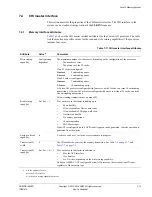
Level 2 Memory System
ARM DDI 0500D
Copyright © 2013-2014 ARM. All rights reserved.
7-20
ID021414
Non-Confidential
Requests not meeting these restrictions cause a SLVERR response on
RRESP
or
BRESP
.
7.7.2
ACP user signals
ACP transactions can cause coherent requests to the system. Therefore ACP requests must pass
Inner and Outer Shareable attributes to the L2. To pass the shareability attribute, use the
encodings described in
Table 7-16
. See
ACP interface signals
on page A-22
for more
information.
Note
This is the same encoding as AxDOMAIN on ACE, except that a value of
0b11
is not supported.
7.7.3
ACP performance
The ACP interface can support up to four outstanding transactions. These can be any
combination of reads and writes.
The master must avoid sending more than one outstanding transaction on the same AXI ID, to
prevent the second transaction stalling the interface until the first has completed. If the master
requires explicit ordering between two transactions, ARM recommends that it waits for the
response to the first transaction before sending the second transaction.
Writes are generally higher performance when they contain a full cache line of data.
If SCU cache protection is configured, writes of less than 64 bits incur an additional overhead
of performing a read-modify-write sequence if they hit in the L2 cache.
Some L2 resources are shared between the ACP interface and the cores, therefore heavy traffic
on the ACP interface might, in some cases, reduce the performance of the cores.
You can use the
ARCACHE
and
AWCACHE
signals to control whether the ACP request
causes an allocation into the L2 cache if it misses. However if a CHI master interface is
configured then, to ensure correct ordering of data beats, ACP reads that miss always allocate
into the L2 cache.
Table 7-16 Shareability attribute encoding
AxUSER[1:0]
Attribute
0b00
Non-shareable
0b01
Inner Shareable
0b10
Outer Shareable
















































